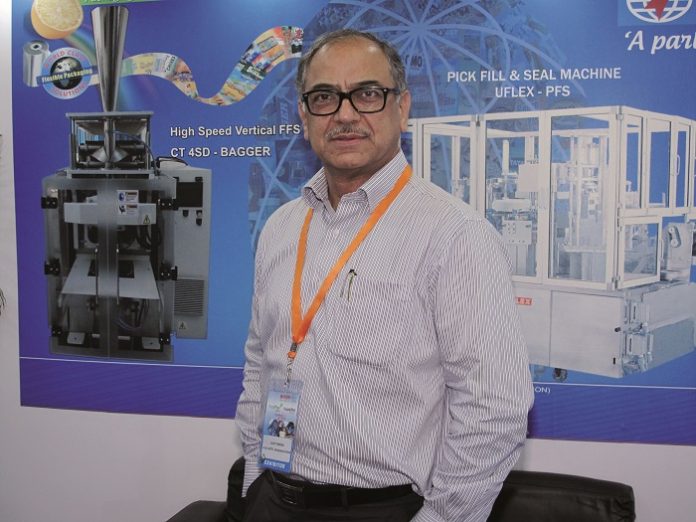
In countries like USA, CI flexo is popular because the cost of gravure cylinders is very high compared to flexographic plates. Although in India the cost difference is not as much, there is still a difference and thus the cost of CI flexo printing is considered to be lower.
Speaking about the demand for CI flexo presses in India, Ajay Tandon, president and CEO of Uflex’ engineering and new product development says that CI flexo demand is picking up. Uflex recently shook hands with an Italian company to manufacture gear and gear-less CI flexo presses under a technology transfer agreement at Uflex’s engineering plant in Noida. Ajay Tandon says, “In Asia gravure printing is predominant, so the concentration of machines is gravure. In Europe it is 50% gravure and 50% CI flexo. In the US, it is 80% CI flexo and just about 20% gravure. In India, flexo is picking up quite fast since the last three to four years. Since flexo is picking up, we thought it to be the right time to get into flexo press manufacturing. Today, since the quality of CI flexo is very close to gravure, we see a very good potential for CI flexo machines.”
Tandon further explains that there are a couple of reasons behind the increased demand for CI flexo presses in India. He says, “On gravure it is very difficult to print on polyethylene because gravure has separate stations and there is always a tension when the film is being printed. But in CI flexo, the film moves around the CI drum with which it is in contact, so there is no stretching of the film. When there is no stretching you get better registration specially on polyethylene. Secondly, in countries like USA, CI flexo is popular because the cost of gravure cylinders is very high compared to flexographic plates. Although in India the cost difference is not as much, there is still a difference and thus the cost of CI flexo printing is considered to be lower. Thirdly, on CI flexo presses you can take smaller batches whereas in gravure you have to take larger batches since there will be more waste because gravure presses are longer and more sequential settings have to be done. In addition to the large number of brands, many brands are also producing many variants of the same products – so the runs are becoming smaller.”
Trends – inks, gravure and flexo
 Solvent-based gravure and flexo inks used in packaging always retain small amounts of solvent in the final package. When measured and controlled, this is not a problem. However, excess solvent retention will cause the package to have an odour and can spoil the taste of food products. In this kind of printing, the safety of the substrate depends on the kind of ink being used. Tandon says, “The traditional inks are heavily solvent-based inks with toluene. But in developed countries, they have stopped using toluene inks and use more of polyurethane resins for inks. In India also, that trend is coming in and after the printing and lamination is done, a lot of solvent retention tests are done through the gas chromatography (GC) readings to quantify the retention levels of the various solvents.” In terms of managing solvent retention, the trend is to minimize solvent use. Moreover, the quality of presses has improved which evaporates the solvent, says Tandon.
Solvent-based gravure and flexo inks used in packaging always retain small amounts of solvent in the final package. When measured and controlled, this is not a problem. However, excess solvent retention will cause the package to have an odour and can spoil the taste of food products. In this kind of printing, the safety of the substrate depends on the kind of ink being used. Tandon says, “The traditional inks are heavily solvent-based inks with toluene. But in developed countries, they have stopped using toluene inks and use more of polyurethane resins for inks. In India also, that trend is coming in and after the printing and lamination is done, a lot of solvent retention tests are done through the gas chromatography (GC) readings to quantify the retention levels of the various solvents.” In terms of managing solvent retention, the trend is to minimize solvent use. Moreover, the quality of presses has improved which evaporates the solvent, says Tandon.
Uflex at PackPlus 2016
At PackPlus Uflex’s engineering, holography and cylinder divisions were present at a joint stand. The engineering division displayed its solvent-less Standard S Laminator and slitting machine Eco-Slit 450. It also displayed its high speed vertical FFS machine CT 4S- Bagger which was launched five months ago and can run up to a speed of 110 pouches a minute. “We have already installed 35 to 40 CT 4S machines in the last three to four months. Apart from these, we have orders for 50 to 60 machines which need to be delivered in the next two months,” says Ajay Tandon, Uflex president and CEO – engineering and new product development.











